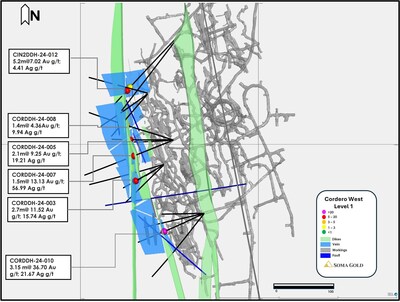VANCOUVER, BC, July 16, 2024 /CNW/ – Soma Gold Corp. (TSXV:SOMA) (WKN: A2P4DU) (OTC:SMAGF) (the “Company” or “Soma“) is pleased to announce initial results from the 2024 diamond drill program at the Cordero Mine on the Bagre Project in central Colombia (Figure 1). Nineteen diamond drill holes, totalling 2,759m of drilling, were completed by underground and surface drill rigs (Figure 2). The drilling to date has targeted the up-dip extension of gold-bearing quartz veins commonly referred to as the “Cordero Vein.” The Cordero Vein has been successfully mined from Level 2 to Level 6 of the mine. Earlier attempts to develop above Level 2 were terminated in a cross-cutting mafic dyke. The Q1/Q2 drill program was designed to evaluate the western side of the dyke for the continuation of the Cordero Vein, a target that had not previously been tested. Assays from the drill holes are reported and discussed in this press release.
Highlights include the following drill intercepts:
- CIN2DDH-24-012 5.2m at 7.0g/t Au incl. 0.5m at 47.0g/t Au and 0.5m at 17.7g/t Au
- CORDDH-24-003 2.7m at 11.5g/t Au incl. 0.5m at 28.6g/t Au, 0.5m at 14g/t Au, and 0.55m at 10.1g/t Au
- CORDDH-24-005 2.1m at 9.3g/t Au incl. 0.6m at 31.1g/t Au
- CORDDH-24-007 1.5m at 13.1g/t Au incl. 0.6m at 32.6g/t Au
- CORDDH-24-010 3.7m at 31.4g/t Au incl. 0.6m at 189.2g/t Au
The Cordero Deposit is hosted in the El Carmen Stock, which is comprised of coarse-grained tonalite, diorite, and gabbroic phases. The quartz veins are formed as laminated fault-fill veins within a sinistral brittle-ductile shear zone. They are interpreted as conjugate shears within a steeply-dipping, north-striking regional shear zone. The controlling shear zone also hosts the Los Mangos Deposit 2.8 kilometres to the north. The quartz veins within the Cordero Deposit form a series of en echelon segments that consistently step to the right along strike. The veins have been repeatedly reactivated and exhibit three distinct phases of development: early barren quartz veins, sphalerite + galena + pyrite + gold mineralization controlled by microfractures, and brittle fracturing along the margins of the veins filled with quartz + pyrite + tellurides + gold. Gold mineralization is associated with the latter two phases of vein development. The final stage of brittle fracturing and micro-breccia is commonly associated with bonanza gold grades. The veins are subsequently crosscut by aphanitic mafic dykes and numerous brittle faults. The brittle faults are generally dextral and offset the quartz veins from <1.0m to 10’s of metres. The late brittle faults commonly dismember the mineralized veins into short strike-length segments, the continuity of which is difficult to discern from drill data.
Soma’s Vice President of Exploration, Chris Buchanan, stated, “The potential for mineralized quartz veins west of the dyke that halted stope development on Level 2 of the Cordero Mine was previously untested. The initial high-grade intercepts west of the dyke are exciting and represent an opportunity to add additional ounces to the mine plan that can be accessed from current underground developments.”
Table 1 presents the composited assay results from nineteen drill holes in Level 1. Seven of the drill holes intersected mineralized quartz veins, five of which contain bonanza grades of gold. Notably, drill holes CORDDH-24-003 and CORDDH-24-010 also contained visible gold in the high-grade intervals (see Plate 1). The drill holes that did not intersect the main quartz vein typically intersected one of the younger mafic dykes or a fault gap between the vein segments. Seven drill holes at the south end of the Level 1 zone have intersected quartz vein structures containing sulphides, but assays are pending for these holes.
In 2021 and 2022, Soma mined Level 2 of the Cordero Vein for a combined strike length of approximately 355m, which the Company believes remains open on strike. Level 2 stopes along the vein were terminated up-dip at the contact of a mafic dyke. The Q1 drill program intersected high-grade quartz veins over a strike length of 237m on the west side of this dyke system. Figure 3 presents the geological interpretation of the western, up-dip continuation of the mineralized veins, cross-cutting dykes, and late brittle faults. The younger dykes and faults dismember the quartz vein into approximately eight vein segments with either dextral offset or missing sections of the veins within the dykes. The location of high-grade composite assays is highlighted by representative spheres and labels.
A long section of the drill intercepts is presented in Figure 4. The high-grade intercepts are at approximately the same elevation but are contained in different segments of the quartz veins. Additional surface drilling will be completed to determine the up-dip extent of each interpreted vein segment and better evaluate the distribution of gold grade within the segments. The Soma exploration team is currently working on an internal resource based on this geological model. The internal resource model will be used to plan the development work required to start mining operations on Level 1 in late Q3 or early Q4 of 2024.
In addition to supporting mining operations at Cordero Mine, Soma’s exploration team continues to evaluate numerous small-scale mines in the vicinity of Machuca. Two out of three planned soil grids have been completed. These grids were designed to determine the continuity of gold mineralization between the informal mines along the Otú Fault. The main Machuca soil grid has delineated three soil anomalies up to 900m along strike. Follow-up prospecting along the anomalies is currently underway, and Soma expects to initiate drilling on the soil anomalies in Q3 2024. Soma also continues to work with the local communities on the Machuca Property as part of its ongoing ESG program.
Table 1 Composited Au assays from Cordero Level 1 Drill holes
|
Hole ID |
From |
To (m) |
Length |
Composite Assays |
|
CORDDH-24-001 |
no sample has more than 1g/t Au |
|||
|
CORDDH-24-002 |
71.1 |
71.6 |
0.5 |
0.5m@1.1 g/t Au |
|
CORDDH-24-003 |
74.15 |
76.85 |
2.7 |
2.7m@11.5 g/t Au |
|
incl. |
0.5m@14.3 g/t Au |
|||
|
and |
0.55m@10.1 g/t Au |
|||
|
CORDDH-24-004 |
no sample has more than 1g/t Au |
|||
|
CORDDH-24-005 |
82.8 |
83.3 |
0.5 |
0.5m@1.3 g/t Au |
|
CORDDH-24-005 |
94.2 |
96.3 |
2.1 |
2.1m@9.3 g/t Au |
|
incl. |
0.6m@31.1 g/t Au |
|||
|
CORDDH-24-006 |
no sample has more than 1g/t Au |
|||
|
CORDDH-24-007 |
92.65 |
94.15 |
1.5 |
1.5m@13.1 g/t Au |
|
incl. |
0.6m@32.6 g/t Au |
|||
|
CORDDH-24-008 |
107.15 |
108.55 |
1.4 |
1.4m@4.4 g/t Au |
|
incl. |
0.7m@7.7 g/t Au |
|||
|
CORDDH-24-009 |
no sample has more than 1g/t Au |
|||
|
CORDDH-24-010 |
89.6 |
93.3 |
3.7 |
3.7m@31.4 g/t Au |
|
incl. |
0.6m@189.2 g/t Au |
|||
|
CIN2DDH-24-012 |
118.7 |
120.5 |
1.8 |
1.8m@1.1 g/t Au |
|
CIN2DDH-24-012 |
128.6 |
130.6 |
2 |
2.0m@2.9 g/t Au |
|
CIN2DDH-24-012 |
134.73 |
139.93 |
5.2 |
5.2m@7.0 g/t Au |
|
incl. |
0.5m@47.0 g/t Au |
|||
|
and |
0.5m@17.7 g/t Au |
|||
|
CIN2DDH-24-017 |
no sample has more than 1g/t Au |
|||
|
CORDDH-24-011 |
– |
– |
– |
Pending results |
|
CORDDH-24-012 |
– |
– |
– |
Pending results |
|
CORDDH-24-013 |
– |
– |
– |
Pending results |
|
CORDDH-24-014 |
– |
– |
– |
Pending results |
|
CORDDH-24-015 |
– |
– |
– |
Pending results |
|
CORDDH-24-016 |
– |
– |
– |
Pending results |
|
CORDDH-24-017 |
– |
– |
– |
Pending results |
The Otú fault system (“Otú Fault”) has a strike length of over 100 km, from Aris’s Segovia-Remedios mines (TSX: ARIS) in the south to Nechi in the north (where it is buried by younger sedimentary overlap sequences). Soma’s property holdings now cover more than 56km of this strike length. High-grade gold mineralization occurs along the entire strike length of the Otú Fault. The high-grade gold occurs in brittle-ductile to brittle quartz veins that form during later stages of deformation along the Otú Fault. Across the district, the quartz veins display orientation patterns that suggest the veins form in conjugate faults associated with brittle faulting on the Otú Fault. Notable mines along the Otú trend include Segovia-Remedios, La Aurora, El Limon, Le Ye, Los Mangos, and Cordero. The Machuca Property is located along a critical segment of this regional fault structure and contains numerous indications of high-grade gold mineralization.
QA/QC Statement
Soma follows a comprehensive QA/QC program to ensure the reliability of assay data collected from its exploration programs. All samples are sawn or split in half, with one half being returned to the core box for storage. The second half-core is placed in a labelled plastic bag with a tag, document, and sealed for shipment. Batches of samples are shipped to Actlabs Colombia SAS (Actlabs) in Rio Negro with security tags and documented chain of custody.
Pulps of each sample are prepared in Rio Negro. Pulp samples are then shipped to Actlabs Canada for multi-element analysis. All samples are analyzed using package 1E3, an ICP-MS analysis that provides the concentration of 51 elements. Fire assay analysis for gold and Silver is completed by Actlabs in Rio Negro. Thirty-gram aliquots of each sample are analyzed for gold using a standard fire assay with an atomic absorption finish, package 1A2. Overlimit samples are subjected to an additional fire assay with a gravimetric finish, package 1A3-30, to determine the gold concentration.
A comprehensive QA/QC program has been implemented to monitor the reliability of assay data collected during exploration programs. The program includes the regular insertion of certified blanks, duplicates, and certified OREAS standards. Assays of the QA/QC samples are automatically compared to the certified value and standard deviations in the database.
Qualified Person Statement
Mr. Chris Buchanan, P.Geo, is Soma’s Vice-President of Exploration and a Qualified Person as defined by National Instrument 43-101. Mr. Buchanan has reviewed the technical information disclosed in this press release.
ABOUT SOMA GOLD
Soma Gold Corp. (TSXV:SOMA) is a mining company focused on gold production and exploration. The Company owns two adjacent mining properties in Antioquia, Colombia with a combined milling capacity of 675 tpd. (Permitted for 1,400 tpd). The El Bagre Mill is currently operating and producing. Internally generated funds are being used to finance a regional exploration program.
With a solid commitment to sustainability and community engagement, Soma Gold Corp. is dedicated to achieving excellence in all aspects of its operations.
The Company also owns an exploration property near Tucuma, Para State, Brazil that is currently under option to Ero Copper Corp.
On behalf of the Board of Directors
“Geoff Hampson”
Chief Executive Officer and Chairman
Neither the TSX Venture Exchange nor its Regulation Services Provider (as that term is defined in the policies of the TSX Venture Exchange) accepts responsibility for the adequacy or accuracy of this release.
All statements, analysis and other information contained in this press release about anticipated future events or results constitute forward-looking statements. Forward-looking statements are often, but not always, identified by the use of words such as “seek”, “anticipate”, “believe”, “plan”, “estimate”, “expect” and “intend” and statements that an event or result “may”, “will”, “should”, “could” or “might” occur or be achieved and other similar expressions. Forward-looking statements are subject to business and economic risks and uncertainties and other factors that could cause actual results of operations to differ materially from those contained in the forward-looking statements. Forward-looking statements are based on estimates and opinions of management at the date the statements are made. The Company does not undertake any obligation to update forward-looking statements even if circumstances or management’s estimates or opinions should change except as required by applicable laws. Investors should not place undue reliance on forward-looking statements.
SOURCE Soma Gold Corp.

Featured image: DepositPhotos © tschub











